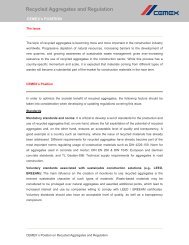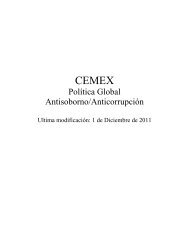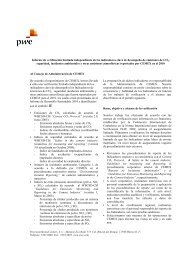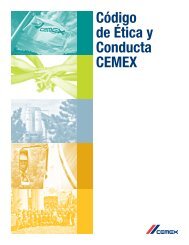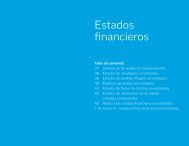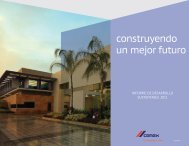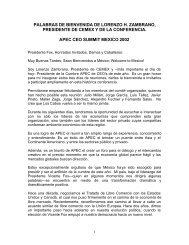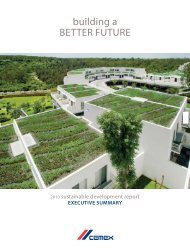building a STRONGER foundation - Cemex
building a STRONGER foundation - Cemex
building a STRONGER foundation - Cemex
Create successful ePaper yourself
Turn your PDF publications into a flip-book with our unique Google optimized e-Paper software.
CEMEX, S.A.B. DE C.V. AND SUBSIDIARIES<br />
Notes to the Consolidated Financial Statements – (Continued)<br />
As of December 31, 2010, 2009 and 2008<br />
(Millions of Mexican pesos)<br />
In 2006, in order to take advantage of the high wind potential in the “Tehuantepec Isthmus,” CEMEX and the Spanish company ACCIONA<br />
formed an alliance to develop a wind farm project for the generation of 250 Megawatts (MW) in the Mexican state of Oaxaca. CEMEX acted<br />
as promoter of the project, which was named EURUS. ACCIONA provided the required financing, constructed the facility and currently<br />
operates the wind farm. The installation of 167 wind turbines in the farm was finished on November 15, 2009. The agreements between<br />
CEMEX and ACCIONA established that CEMEX’s plants in Mexico should acquire a portion of the energy generated by the wind farm for a<br />
period of at least 20 years, which began in February 2010, when EURUS reached the committed limit capacity.<br />
In 1999, CEMEX entered into agreements with an international partnership, which built and operated an electrical energy generating plant in<br />
Mexico called Termoeléctrica del Golfo (“TEG”). In 2007, another international company replaced the original operator. The agreements<br />
established that CEMEX would purchase the energy generated for a term of not less than 20 years, which started in April 2004. Likewise,<br />
CEMEX committed to supply TEG all fuel necessary for its operations, a commitment that has been hedged through a 20-year agreement<br />
entered with Petróleos Mexicanos, which terminates in 2024. With the change of the operator, in 2007, CEMEX extended the term of its<br />
agreement with TEG until 2027. Consequently, for the last 3 years of the TEG fuel supply contract, CEMEX intends to purchase the required<br />
fuel in the market. CEMEX is not required to make any capital expenditure in the project. For the years ended December 31, 2010, 2009 and<br />
2008, TEG supplied (unaudited) 72.8%, 73.7% and 60.4%, respectively, of CEMEX’s 15 plants’ electricity needs in Mexico during such year.<br />
In 2007, CEMEX Ostzement GmbH (“COZ”), CEMEX’s subsidiary in Germany, entered into a long-term energy supply contract with Vattenfall<br />
Europe New Energy Ecopower (“VENEE”), pursuant to which VENEE has been committed to supply energy to CEMEX’s Rüdersdorf plant for a<br />
period of 15 years starting on January 1, 2008. Based on the contract, each year COZ has the option to fix in advance the volume of energy that it<br />
will acquire from VENEE, with the option to adjust the purchase amount once on a monthly and quarterly basis. According to the contract, COZ<br />
acquired 28 MW in 2008 and 2009, 27 MW in 2010 and will acquire 27 MW per year from 2011 to 2014. COZ expects to acquire between 26<br />
and 28 MW per year starting in 2015 and thereafter. The contract, which establishes a price mechanism for the energy acquired, based on the<br />
price of energy future contracts quoted on the European Energy Exchange, does not require initial investments and was expected to be performed<br />
at a future date. Based on its terms, this contract qualified as a financial instrument under MFRS. However, as the contract is for CEMEX’s own<br />
use and CEMEX sells any energy surplus as soon as actual energy requirements are known, regardless of changes in prices and thereby avoiding<br />
any intention of trading in energy, such contract is not recognized at its fair value.<br />
In April 2008, Citibank entered into put option transactions on CEMEX’s CPOs with a Mexican trust that CEMEX established on behalf of its<br />
Mexican pension fund and certain of CEMEX’s directors and current and former employees (the “participating individuals”). The transaction was<br />
structured with two main components. Under the first component, the trust sold, for the benefit of CEMEX’s Mexican pension fund, put options<br />
to Citibank in exchange for a premium of approximately US$38. The premium was deposited into the trust and was used to purchase, on a<br />
prepaid forward basis, securities that track the performance of the Mexican Stock Exchange. Under the second component, the trust sold, on<br />
behalf of the participating individuals, additional put options to Citibank in exchange for a premium of approximately US$38, which was used to<br />
purchase prepaid forward CPOs. These prepaid forward CPOs, together with additional CPOs representing an equal amount in U.S. dollars, were<br />
deposited into the trust by the participating individuals as security for their obligations, and represent the maximum exposure of the participating<br />
individuals under this transaction. The put options gave Citibank the right to require the trust to purchase, in April 2013, approximately 126<br />
million CPOs at a price of US$2.8660 per CPO (120% of initial CPO price in dollars), as adjusted as of December 31, 2010. If the value of the<br />
assets held in the trust (32.1 million CPOs and the securities that track the performance of the Mexican Stock Exchange) were insufficient to<br />
cover the obligations of the trust, a guarantee would be triggered and CEMEX, S.A.B. de C.V. would be required to purchase in April 2013 the<br />
total CPOs at a price per CPO equal to the difference between US$2.8660 and the market value of the assets of the trust. The purchase price per<br />
CPO in dollars and the corresponding number of CPOs under this transaction are subject to dividend and other antidilution adjustments. CEMEX<br />
recognizes a liability for the fair value of the guarantee, and changes in valuation were recorded in the statements of operations (note 12C).<br />
F-53



